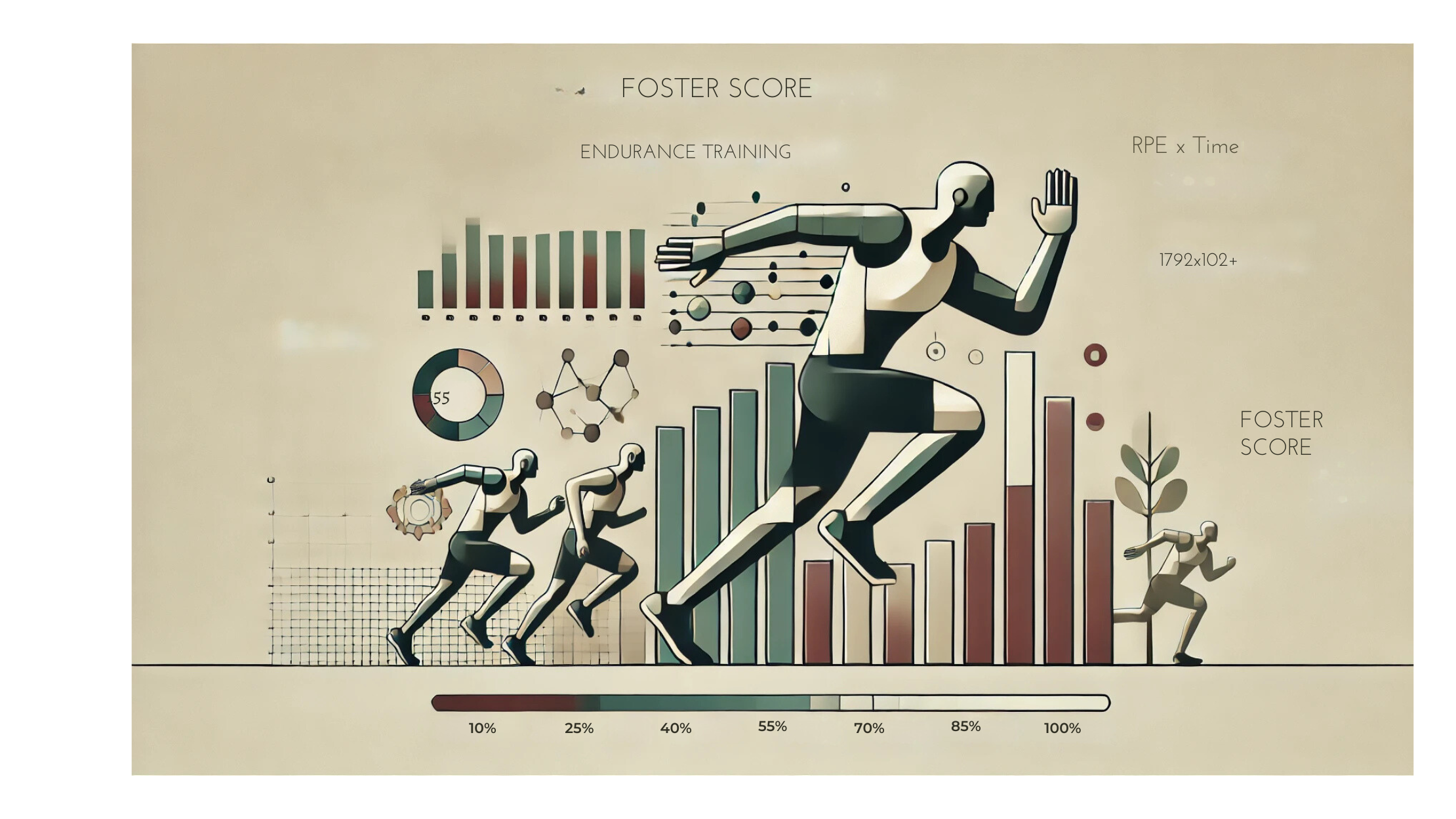The Foster Score developed by Dr. Carl Foster, it is a training load metric that combines your perceived effort with workout duration to give a more complete picture of how hard you’re working.
Why is the Foster Score Useful for Endurance Athletes?
1. It’s Easy to Calculate
One great thing about the Foster Score is its simplicity. You don’t need any high-tech equipment—just a sense of how hard the workout felt and the duration of the session. By combining these two pieces of information, you can get a solid estimate of your total training load. This makes it accessible to athletes at all levels.
2. It Adds Depth to RPE
The Foster Score builds on RPE by adding time into the equation. If RPE tells you how intense the workout was, the Foster Score tells you how much overall stress that workout put on your body. For example, a hard effort for 10 minutes (like sprint intervals) and a moderate effort for 60 minutes (like a long run) might both feel challenging, but their impact on your body is very different. The Foster Score helps capture that difference.
3. It Helps You Monitor Weekly Training Load
Tracking your Foster Score over the course of a week can show you the total load your body is handling. By keeping an eye on these weekly scores, you can make adjustments to avoid overtraining. For example, if your scores are consistently high week after week, you might need to add more rest days to ensure you’re not pushing too hard.
How to Calculate the Foster Score
Calculating the Foster Score is easy! Here’s the formula:
Example Calculation: Let’s say you did a 45-minute workout and rated it as an RPE of 7 (a hard effort). You’d calculate your Foster Score like this:
- In this case, your Foster Score of 315 reflects both the intensity (RPE of 7) and the time (45 minutes), giving you a clear sense of how demanding that workout was.
Foster Score Guide by RPE and Duration
Here’s a quick guide to understanding how different combinations of RPE and duration affect your Foster Score:
- RPE Effort Description Duration (minutes) Example Foster Score
4 Light, 30min – 4 x 30 = 120
6 Moderate, 60min – 6 x 60 = 360
8 Hard, 45min – 8 x 45 = 360
9 Very Hard, 30min – 9 x 30 = 270
10 Maximum Effort, 10min – x 10 = 100
In this example, you can see how different types of workouts (like a long, moderate effort vs. a short, maximum effort) impact your Foster Score. This variety helps you understand the physical toll of different sessions.
Practical Applications of the Foster Score in Training
1. Setting Weekly Training Load Goals
By adding up your daily Foster Scores, you can track your total weekly training load. This allows you to set goals based on your training phase. For example:
- Base Training: Aim for moderate weekly totals, focusing on building endurance.
- Peak Training: Increase your weekly Foster Score totals to push your fitness.
- Tapering: Reduce your weekly Foster Score as you approach race day, allowing your body to recover.
2. Adjusting Workouts Based on Fatigue
If you’re feeling more fatigued than usual, you can use the Foster Score to adjust your workouts. For example, if you have a 60-minute run planned at an RPE of 7, but you’re feeling tired, you might reduce the duration or the RPE, resulting in a lower Foster Score that day. This approach helps you balance hard work with recovery.
3. Spotting Patterns in Your Training
Tracking your Foster Score over time can help you identify patterns in your training. If you see consistently high scores without much rest, it could indicate that you’re at risk of overtraining. By spotting these patterns early, you can add recovery days or adjust your workload to avoid burnout.
Limitations of the Foster Score
While the Foster Score is a helpful tool, it’s not perfect. Here are some limitations to keep in mind:
- Subjectivity of RPE: Since the Foster Score relies on RPE, it’s influenced by how you feel. External factors like lack of sleep, stress, or even weather can make workouts feel harder or easier, affecting your score.
- Doesn’t Track training modalities: Unlike some advanced metrics (like the T2 Score), the Foster Score doesn’t account for which sport type you are undertaking. It measures each workout individually, so it’s best used alongside other metrics if you’re tracking a typical multi-sport training plan.
- Less Detailed Than Heart Rate-Based Metrics: The Foster Score doesn’t consider physiological data like heart rate, so it may not be as precise as metrics.
Using the Foster Score Alongside Other Metrics
For many athletes, the Foster Score works best when combined with other metrics, like heart rate or RPE alone, to provide a well-rounded view of training. For example:
- Foster Score + TRIMP (Training Impulse): Adding TRIMP (a heart rate-based load metric) gives you an objective measure alongside the subjective Foster Score.
- Foster Score + T2: If you’re managing large training volumes, combining the Foster Score with T2 (which includes sport type) can help you fine-tune training load and recovery.
Why the Foster Score is Valuable for Endurance Athletes
To wrap up, the Foster Score is a simple yet effective tool that combines RPE with workout duration to give you a clear picture of your training load. It’s:
- Easy to calculate and doesn’t require technology.
- Useful for setting and tracking weekly training goals.
- Flexible enough to adapt based on your daily energy and recovery needs.
By tracking your Foster Score, you can make more informed decisions about your training, helping you improve over time without overdoing it.
Try Calculating Your Foster Score
Ready to give it a try? Track your RPE and duration after each workout for a week, calculate your Foster Score, and add it up to see your total weekly load. Over time, you’ll start to see how different workouts impact your overall load and how you can adjust to get the most out of your training.
What if want more information about Training Load
Why not have a read of some of our other blogs on this topic:
- RPE – The Modified Borg Scale for perceived effort
- Trimp – Training Impulse using Heart Rate
- Endurance Training Score – also called T2 by Dr. Tony Rice
- Acute and Chronic Training Load – what is this useful for…?
View more content like this

TRIMP: A Science-Backed Way to Measure Training Load in Endurance Sports
In endurance sports like running, cycling, and swimming, tracking training load is essential for performance improvement, injury prevention, and balanced recovery. One of the most
Data Provides Answers – but also Raises Questions
At the 2017 World Rowing Coaches’ Conference, a wide-ranging and interesting discussion about data was had. Covering data collection devices, data management platforms and some philosophies
Ludum live streams The Boat Race Trial Eights 2022
It’s no secret that Ludum was born from the rowing community, we were originally called Rowe.rs after all! But despite the fact that we now


